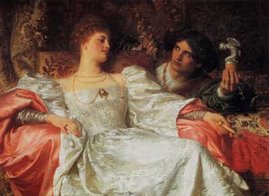 I've been reading John Brewer's comprehensive and insightful review of eighteenth century cultural life for the past week: The Pleasures of the Imagination: English Culture in the Eighteenth Century. As I was reading the chapter entitled "Authors, Publishers and Literature Culture," I was struck by the similarities to the publishing culture of the 21st century. Celebrities such as aristocrats had a much easier time getting published (think of the numerous celebrities today receiving book contracts), though unlike today's celebrity authors, the 18th century celebrity author shunned monetary compensation (Brewer 145). Writers such as Samuel Richardson and Jane Austen struggled to get into print. In fact, as I was re-reading the Broadview edition of Northanger Abbey, I was appalled at the terse communication she received from Crosby & Co., the first publishing house she submitted her manuscript to (I remember hearing this story in a Jane Austen course years ago and even then thinking it was very shabbily done). Crosby & Co. paid 10 pounds for the manuscript but then declined to publish it, and when Austen announced her intent to market her work elsewhere, they replied "there was not any time stipulated for its publication, neither are we bound to publish it. Should you or any one else we shall take proceedings to stop the sale. The MS. shall be yours for the same as we paid for it" (cited in Claire Grogan's Appendix A of Northanger Abbey).
I've been reading John Brewer's comprehensive and insightful review of eighteenth century cultural life for the past week: The Pleasures of the Imagination: English Culture in the Eighteenth Century. As I was reading the chapter entitled "Authors, Publishers and Literature Culture," I was struck by the similarities to the publishing culture of the 21st century. Celebrities such as aristocrats had a much easier time getting published (think of the numerous celebrities today receiving book contracts), though unlike today's celebrity authors, the 18th century celebrity author shunned monetary compensation (Brewer 145). Writers such as Samuel Richardson and Jane Austen struggled to get into print. In fact, as I was re-reading the Broadview edition of Northanger Abbey, I was appalled at the terse communication she received from Crosby & Co., the first publishing house she submitted her manuscript to (I remember hearing this story in a Jane Austen course years ago and even then thinking it was very shabbily done). Crosby & Co. paid 10 pounds for the manuscript but then declined to publish it, and when Austen announced her intent to market her work elsewhere, they replied "there was not any time stipulated for its publication, neither are we bound to publish it. Should you or any one else we shall take proceedings to stop the sale. The MS. shall be yours for the same as we paid for it" (cited in Claire Grogan's Appendix A of Northanger Abbey).Much like self-published authors today, writers such as Samuel Johnson had to get creative to make it in the restrictive publishing world of the eighteenth century. Johnson was both a printer and a publisher, and he used these avenues to have his first novel published (Brewer 125-27). The following line will also sound familiar to authors pursuing publication in this modern age: "The world of eighteenth-century publishing is best understood as an expanding maze or labyrinth, and it offered the potential author many entrances and numerous routes to eventual publication, each full of hazards, pitfalls and dead ends" (Brewer 140). The booksellers had a monopoly on the marketplace, and writers such as Oliver Goldsmith labored long and hard to succeed and achieve publication. As Brewer wryly remarks, when writers applied to booksellers to publish their works, "the author's reception was rarely warm, occasionally tepid and often cold" (Brewer 155). Eighteenth century authors pursued two strategies, both of which could be helpful today. First, they could make sure to target a publisher they knew was interested in their subject matter (Brewer 156). Second, they could seek the help of published author, whose connections could help the aspiring writer (Brewer 158).
One thing that Brewer mentions and that I wish still existed in the 21st century is the literary salon. The opportunity to socialize with other writers and to discuss politics, literature, society, etc. must have been incredibly stimulating. Although writer's conferences do reproduce this experience to an extent, they can be expensive to attend; in most cases, it's difficult to find active groups of writers in some communities, so I would champion the introduction of salons.







No comments:
Post a Comment